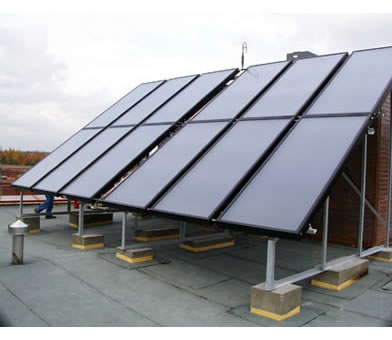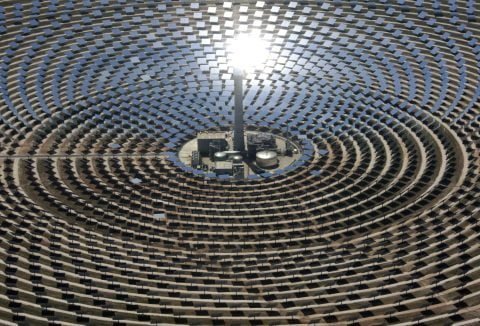A guide shows off row after row of gleaming, black, chrome-coated tubes used in the millions of solar thermal water heaters Himin Solar Energy Group produces each year
The corporate building alone saves 1 million kilowatt-hours by using solar heating, the guide informs his group. But when he is asked how many tons of carbon dioxide emissions the average solar water heater saves, silence fills the hall.
“Normally, in China, we just calculate energy efficiency,” the guide offers finally. “There’s no calculation of carbon dioxide.”
About 1,200 miles to the south, in the economic boomtown of Shenzhen, a similar scenario unfolds. Top officials at the Shenzhen LianChuang Energy Conservation Equipment Co. sit around a conference table, proudly displaying light-emitting diode (LED) lighting that can save 40 to 60 percent of electricity. Across the room, they point to mechanisms that adjust the voltage of factory machine tools and other power equipment, rattling off wattages conserved and dollars saved for their clients.
Yet as the topic turns to the greenhouse gas emissions that trap heat in the atmosphere, the businessmen in short-sleeved button-down shirts shift in their swivel chairs and glance at one another.
“There’s a shortage of electricity in China. We need to save energy,” General Manager Kenny Kong says. Asked specifically about climate change, he says, “Personally, I would like to promote energy efficiency products to every corner. The sky over China will be much more blue in the future.”
From shuttering inefficient factories to investing in LED lighting, energy efficiency is serious business throughout China. But in boardroom after boardroom, the work seems almost completely divorced from the business of reducing greenhouse gas emissions.
Big linkage to energy savings
In more than a dozen interviews with business leaders in wind, solar and other renewable energy industries throughout China, officials repeatedly discussed CO2 emission reductions, using general platitudes about “blue skies,” but were able to offer little in the way of specifics. Until, that is, talk returned to the kilowatt-hours and dollars that could be saved by low-carbon technologies.
“In China, many people understand what energy efficiency is. They think energy efficiency has no relationship with climate change. But they understand how to save energy,” said Jiamin Jin, executive director of the Global Environmental Institute in Beijing.
That’s likely to change soon. Last month, President Hu Jintao announced that China will curb its carbon intensity over the decade to 2020, a move that will be the country’s first overt attempt to control its emissions growth.
Some analysts say China already has a leg up from three years of intense national efforts — fueled not by concerns about climate change but rather by worries about energy security, recent concerns about air pollution and the sheer challenge of providing resources to 1.3 billion people — to boost energy efficiency.
Meanwhile, many argued, the past failure to link energy savings to climate change might actually be a strategy the United States and others could learn from.
“Climate change really originates from a domestic concern, and when you talk about China, you translate that into energy savings and energy efficiency,” said Qi Ye, deputy director of the China Sustainable Energy Program in Beijing.
Call it energy savings or call it emissions reductions, the fact that climate change has not been part of the domestic conversation, he argued, doesn’t change the bottom line: The work has helped slow the rise of China’s greenhouse gas emissions.
‘You get to the same place’
“Essentially, you get to the same place, and it’s actually a very effective strategy if you address the global issue in terms of local need,” Ye said. “That helps you move into actions. People act from what they really care and believe. They don’t act on what you believe is most important.”
Energy experts note that between 1980 and 200O, China invested heavily in energy efficiency and imposed energy quotas and other policies that enabled the country to quadruple its gross domestic product while only doubling its energy use. Then things changed. Between the country’s building boom and its rapid growth of energy-intensive industries in an economy based primarily on coal, energy efficiency got stuck on the back burner. Between 2000 and 2005, the country’s energy consumption more than doubled.
By 2006, China had put in place a five-year plan to once again improve its energy efficiency. The target: Reduce energy intensity — or the amount of energy consumed per unit of GDP produced — 20 percent by 2010.
It’s getting there in a variety of ways. Right now, about one in every 10 Chinese households uses a solar thermal water heater, sourcing one of the biggest uses of electricity with clean energy. Mandatory energy efficiency standards for electronics and home appliances went into effect about four years ago. In Shenzhen, the local government is spending $3.75 billion on LED research and development projects through 2016, and a new national rebate program subsidizes the purchase of energy-efficient light bulbs 30 to 50 percent.
Meanwhile, two of the programs getting some of the most press attention in China have been the shuttering of old, inefficient coal-fired power plants and an agreement with the country’s 1,000 most energy-intensive industries to meet efficiency requirements. That program is aimed at reducing 33 percent of China’s primary energy demand and 50 percent of its electricity use.
Cutting energy intensity, counting profits
According to the National Development and Reform Commission, China’s energy intensity decreased by about 10 percent between 2006 and 2008. In the first half of 2009, the government reported, energy intensity declined 3.35 percent. Opinions are mixed on whether the country can meet its 2020 goal.
If it does, according to Chinese authorities, it will have blocked about 1 billion tons of CO2 from wafting into the atmosphere.
“For almost forever, it’s been clear that an energy intensity goal is pretty much the same as a carbon intensity goal. For a country like China, it really is the case,” said William Chandler, director of the energy program at the Carnegie Foundation for International Peace.
But Julian Wong, a senior energy policy analyst at the Center for American Progress, noted that energy efficiency, while all well and good, doesn’t alone influence a country’s absolute emissions. And on that score, China is steadily rising. It is the world’s largest emitter, at 6.8 billion tonnes annually, and a recent report from a Chinese think tank estimated that the country will likely reach 8.8 tonnes by 2035.
Speaking before the United Nations last month, President Hu promised that China would reduce its carbon intensity by a “notable margin,” but did not offer specific targets. That, presumably, will be a negotiating point as countries head into an intense round of negotiations in Copenhagen this December toward a possible global emissions treaty.
Environmental activists in China call it a significant step and an important signal that the government wants to decouple emissions from economic growth. And, they say, it will help focus more attention throughout the country on the problems of rising emissions.
For now, though, business leaders like Jason Yang, who manage a sales team at Shenzhen Bang-Bell Electronics, say they want to do their part for the environment — and their wallets. Standing over a giant model LED streetlamp lying on a conference room floor, he talks excitedly about the kilowatt-hours his company saves cities with the million pieces of fixtures they sell each year.
Sure, the lights also reduce CO2 emissions, Yang said. But, he adds, “We mostly focus on energy savings. Energy efficiency is most important of all.”
Share your industry press now!
Are you a PR agency or sustainability-focused organization? Join the World of Renewables network FREE today and gain exclusive access to our platform to promote your business, share the latest industry news, and connect with a global audience of 700,000+ renewable energy professionals.
Register Now to start posting your updates and showcase your expertise to a highly engaged, environmentally-conscious community.
Find out more about our Content Partnership Programs.*2024 AWARD WINNER* Websites & Mobile Sites, Webby Winner, Peoples Voice 2024






















